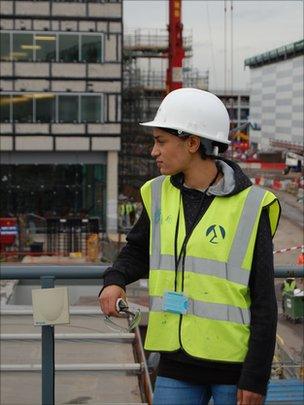Women make their mark on the 2012 Olympic site
- Published
Tony Coyle: female workers 'have a calming effect'
There may not be many of them, but women at the Olympic site in East London are making their presence felt.
As the staff bus trundles onto site, women - in their hard hats and safety gear - can be spotted working away in the main car park, drilling and hefting various bits of equipment.
"I've been actually quite shocked, you can see the ladies as you come in. I've recently met an electrician, she's only 17 and she's doing an apprenticeship which I think is brilliant," says apprentice Samantha Paul.
According to the figures from the Olympic Delivery Authority (ODA) women in trades make up approximately 6% of the construction staff on the site, compared with the national average of around 1%, a figure which has been static since 2003.
"There is an Olympic effect," says Tony Coyle of Carillion, project manager for the Olympic media centre.
"People want to be here, they want to be in on it.
"It's not going to happen again, maybe in their lifetime, and they want to be involved. That applies as much to the ladies as it does men and I think that's part of the reason why the Olympics are doing so well with their female level of employment."
Breaking stereotypes
So how has the site managed to up its game in the world of female builders?
As the 2012 managers are eager to point out - diversity was one of the keys to the UK winning the 2012 bid.
Lorraine Martins, Head of Equality, Inclusion, Employment & Skills at the on site apprentice hub, explains that a combination of factors has come into play.
Special taster days have been set up giving local women the chance to work with big machinery, and prospective employees have had help with finding childcare and healthcare.
Meanwhile, the ODA itself has been finding new ways of getting more females on site - targeting local colleges for potential recruits, testing them out and channelling them into the appropriate courses, as well as offering on the job learning.
Fitting in
All of these factors have helped break down the usual barriers preventing women from getting into construction.
"The number of women here has increased over time, supplemented with work placements... where people are getting experience with some of best in the industry," says Ms Martins.
"It's part and parcel of a broad range of approaches, and what contractors say is that it is quite a positive environment with women on the park. They're impressed with the women so it augurs well for construction."
So how have the girls been managing in this male-dominated world?

Sometimes the tough physical demands of the job can be a problem, says Ms Paul
"They're doing very well, it has been seamless," says Carillion's Mr Coyle, project manager for the Olympic media centre.
"On site they're well accepted by the workforce. They fit in very well they actually take the pains to understand what it is they have to do and do it properly. We're pleased to have them."
But while the powers that be say the women are welcome, it's interesting to see how the ladies themselves have coped.
Ms Paul, an apprentice at the Astins Institute - which launched a £1m training facility in Battersea aimed at getting more women into construction - has experienced a few hiccups along the way.
"The main things have been juggling it with my home life because its quite strenuous, it's a lot of labour work. When you get home you're quite tired but you still have to cook dinner and all those things," she says.
"Apart from that there's not really been many problems at all, most people accept you on site as a lady which I was very apprehensive about.
"But I'm now work with a gang of three and we get on like a house on fire.
"Basically it's been a lot more work and I've had a lot more opportunities to work alone," she adds.
Building a future
So while Samantha believes the Olympics have offered her a chance to get ahead, will they leave a legacy for the construction industry?
"For it be really successful there needs to be some structural changes in the way the industry is set up," argues Mr Coyle.
Other industries have managed to address issues such as as how companies can cope with demands facing many women workers, such as a sudden need to take children to the doctor or simple childminding problems.
"All of those issues need to be thought about in construction, and benefit taken of the really big projects [in order to] put in the kind of infrastructure that will demonstrate it is possible and productive to have more and more women working in the industry," he adds.
"I think we need to do it - when the economy recovers we will be short of good labour again and good workers again and I think that's our opportunity to make a change for the better."